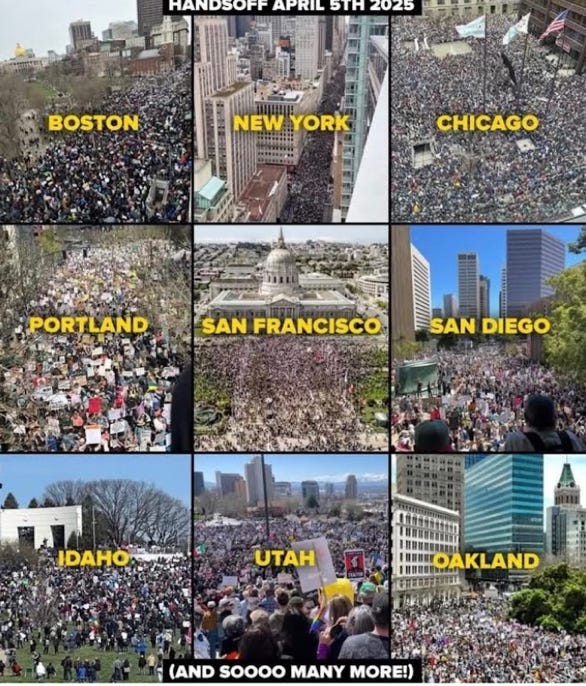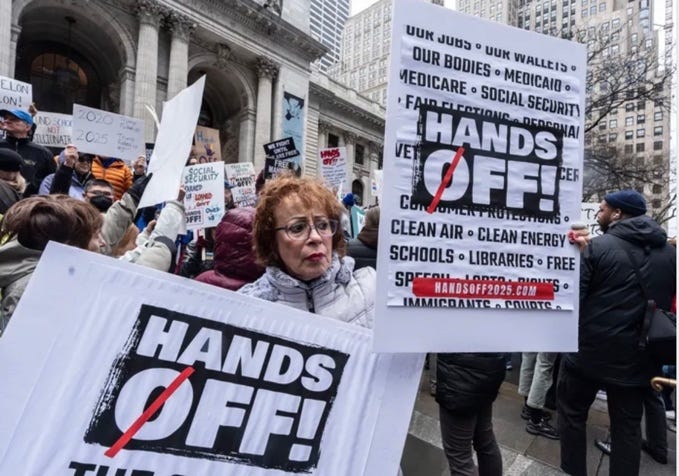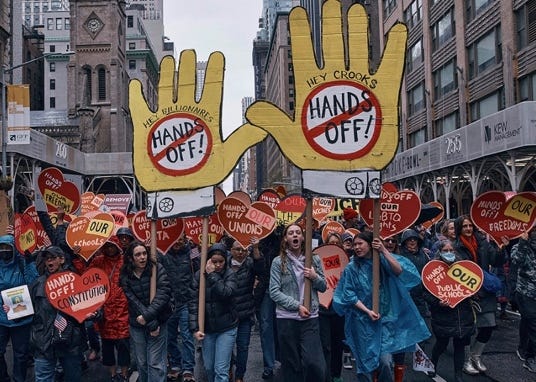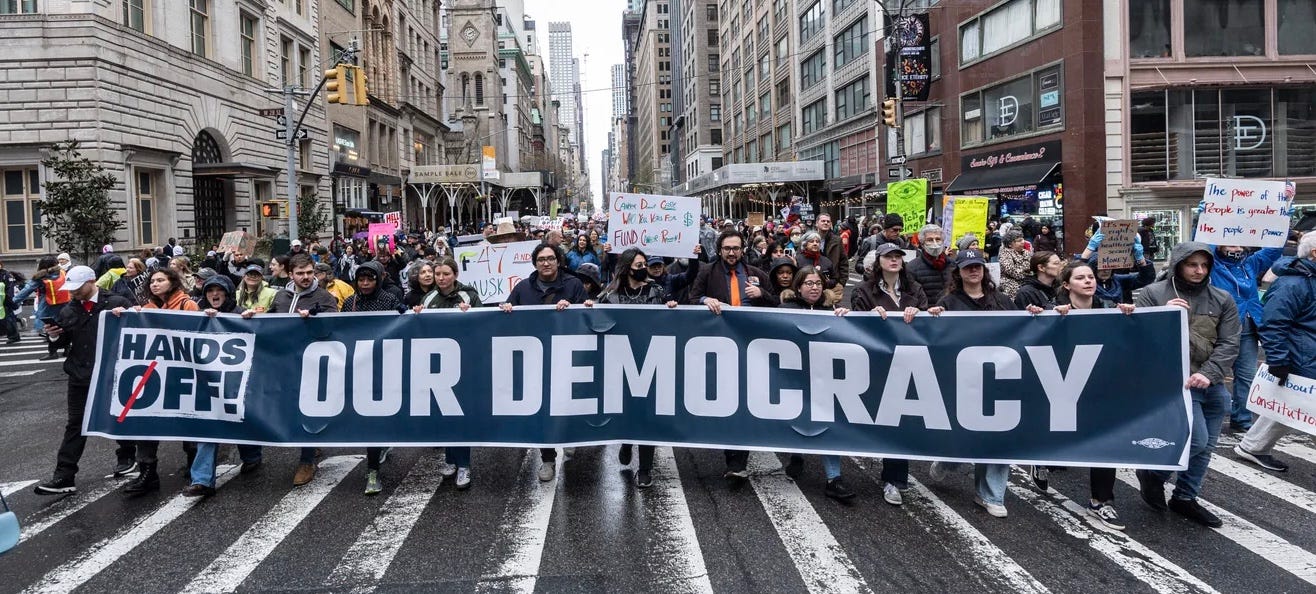Yes mobilize. Now let's organize!
The April 5 Shut It Down! protests brought 3.5 million people into the streets in 50 states -- a true show of resistance. But to really stop Trump, we need to organize and strategize.
Calling All Strategists
Over 3.5 million people joined Shut It Down! events in all 50 states
Days 75 & 76 of the Trump coup….
I thought when I launched this private journal that I could balance it with the other reporting I have set myself the task of doing, to cover the unfolding Trump coup. When I started this one in January, I did so to bear witness for myself (albeit shared with a public) how it felt and how my circle was responding. As I said early on, I’d always been curious about how it had been for my parents to experience the rise and arrival of Hitler in Europe, when they were younger people. Now I know.
It’s exhausting, and mentally, it demands effort to balance the flood of mostly negative and alarming news and developments with positives – with not only evidence of popular resistance to the coup makers, but all the positive elements of life that are always at our reach. I’m talking about art and beauty and connection with others and everything that is magnificent about life that make it worth savoring and defending so hard.
In other words, my own balance has been off, and now I know that is how my parent’s European circle and their generation of younger people felt as Hitler rose and too few acted quickly enough to stop his rise.
I am still determined to cleave my private time to write here, and to bike around the city, and to do things that give me personal pleasure, including seeing art and trying to read the many good books I’ve promised to read, but it’s going to be more challenging to do that than I thought. I should not be surprised. In the late 80s into 90s, as the AIDS epidemic kept growing and my own engagement followed, I hardly slept for a decade. The days were whirlwinds of activity and I constantly felt like I was racing to help put out a 5-alarm fire. Here I am, here we are, again. But this one is not concentrated on sectors of people the way the early AIDS epidemic was. This one is the whole of the US and now, with this week’s Trump coup tariffs, it’s a global assault.
I don’t want to report too much here; I want to stay personal. Because, even as I write, I can feel myself needing to take a deep breath or two, to calm myself even more, to draw a longer breath that is needed for what I know very well already is the long, long haul of the political fight to come. I’m an optimist, but I’m a realist. I can see this American Trump coup very clearly, and I have had the benefit of reading the vision playbook, Project 2025, very closely, since late 2023. So when things happen every day – wholesale routing of a federal department, mass firing of agency workers, illegal seizures of people suspected of being in the US without authorization – I am not surprised, I nod my head in confirmation that the plan is being implemented almost verbatim. It stiffens my spine, my resolve, to resist. But it doesn’t shock me as it shocks so many around me. It’s still deeply upsetting.
April 5: Delivering a clear message via millions of voices and great signs
Seth Harrison/The Journal News
Over the past two days more people in my closer circle are a lot more upset than before, too, because now the attacks are hitting them more personally. Them, because they have work pensions and 401Ks that represent their security in the future, their retirement nest eggs. I don’t. I’m not proud of that, but I opted, or by default, I ended up not working for big companies but working as an independent journalist for so many years, and did not accrue a 401K. But my heart hurts for them and so many people across America who are panicking and suffering and feel helpless to see a six to ten percent disappearance of their 401K nest egg funds as the stock market tumbles in response to Trump’s politically-driven tariffs.
The numbers mean they lose thousands of dollars a year or month that represent the difference between a degree of stability and comfort and their bucket-list future pleasures versus the prospect of a survival mentality and real poverty if not penury and even losing homes or failing to pay rent and not being able to see a safe future. They may rely on Medicare and are incredibly worried their Social Security – their hard-earned taxed wages – will be greatly cut or gutted. The safety net, never firm, feels precariously full of holes.
I understand; I feel the deepest sense of solidarity and concern for them. They feel quite helpless and uncertain what to do because they didn’t personally invest their own retirement funds and they don’t know if they can trust the brokers who did and they aren’t sure about the best investment moves to make in a free-falling world of dropping stocks and bonds and they are trying to play catch up to better understand Trump’s logic behind the crazy tariffs, which is what most economists they trust deem them, as they check the Nasdaq every night. I know, better now, how Americans felt when the stock market crashed before the Great Depression. How the middle and working class crashed.
Not that we are there yet; we aren’t, and I hope we won’t be. BUT I won’t be surprised if we go to these worst limits. We are in fact dealing with a political gang of thieves, as I think of who’s in charge and their goals, which is above all, power, as well as profit. I have been rather surprised at how many political pundits have been trying to sort out Trump’s tariff’s as if they were designed to make economic sense, versus being a pure power play – another step of consolidating his power. Have they not read the playbook on autocracy? Are they not seeing how Trump – and his backers Stephen Miller and Russell Vought and others cheering him on – has moved to try to punish private universities and law firms by threatening to take federal funds or federal contracts away from them?
Toon: Michael De Adder
He is seeking to cripple America – and the world, too – by using tariffs, which are taxes, to financially threaten them. Once they are hurt, and down, and a bit desperate, he can selectively ask them to do what he wants and, if they agree, he’ll restore some of the money. He’ll make individual deals with them as he has Columbia University and the law firms who capitulated, who now grossly agreed to do pro bono work for the bully and his minions. That’s the Trump carrot-and-stick approach to dictatorship.
And all the while Trump and his camp will game the system. They are primed as the insider short sellers to snap up the fallen stocks and drive them back up, and profit beyond handsomely. The tariffs are robber baron tactics, disguised as a US president aggrieved by unfair trading deficits with other countries.
I’m not a financial person, so it helped me today to have a writer in The Economist offer a metaphor I could grasp. Imagine if you asked someone to provide you a service but required them to buy an equivalent value of goods from you? Trump is treating the services we buy from others as a trade deficit. So if I get some shoes from a store in France, they have to buy something from me in the US so it’s fair. I better understand the absurdity of this logic. Anyway, none of the math makes much sense to me when I read what others are trying to understand.
It makes more sense when I hear Elon Musk arguing anew for a full-free trade zone for the world, one in which the tech robber barons he hangs with will be freer to, well, kind of rob. Meaning, profit without paying taxes or following any rules, which they already largely seek to do. Musk, anyway, has a vision for the global economy. He won’t get to Mars, but he would not mind trying to live in Greenland or Panama if it could be taken for the US and given to his Silicon Valley bros to run. Musk and his friends call it a plan to “revitalize Western Civilization” and they’re serious about it.
I have spent some time these past two months reading about the right-wing tech billionaire bros from Silicon Valley that include JD Vance and Peter Thiel, his mentor. Thiel is one of the Pay Pal Mafia tech engineers now acting as shadow advisors to the DOGE, the private entity Trump created to allow Musk to retool our government and install new AI bots to access all our data to use for their own profit. To make the US government a client to a cabal of private business leaders who now own the technology and systems they’ve installed on our government servers. Musk’s vision for America is to become a version of his all-in-one software and communications platform, X. That’s what the DOGE, staffed by X and Space X tech engineers devoted to Musk, is doing.
The Silicon Valley bros dream of a global free trade world in which they can live apart from others in free trade zones and mini-networks that replace our current cities and states and only operate under rules they make and enforce. Futuristic cities run on AI and funded by cryptocurrencies that will exclude the poor and exist as their dystopia wet dream of a future. One where white people who are very rich live, guarded by AI sentinels, and maybe a few select non-white people who want to be seen as white. After all some of the tech titans are of mixed Indian heritage. If you’re ultra-rich, you can pass.
Musk won’t get to Mars, but he would not mind trying to live in Greenland or Panama if it could be taken for the US and given to his Silicon Valley bros to run. He and Thiel have worked hard to convince Trump to get Greenland so they can try. They call it a plan to “revitalize Western Civilization” and they’re serious about it. Thiel already launched a free trade zone city like it called Prospera on the island of Roatan in Honduras. It has its own administrative structure and civil code. It’s one of several proposed city projects called “network states” that will replace our existing states and even country boundaries in the future rad right libertarian vision.
The bros want to dispense of our current system of cities and states and laws and even borders. They want free trade zones. Trump’s tariffs could push their dream closer, rewriting the rules of global trade. They now scheme of building a model city called Praxis in Greenland, a white elite antiseptic city of the future, one run on cryptocurrencies, a model of bot efficiency. A techno-libertarian city upon a hill, as one writer put it. It’s not a sci-fi fantasy, though it is darkly dystopian. Move way over, Alexa.
They’re salivating, watching the Trump tariffs cause chaos. They have so much money that even as their own stocks take a hit, they’re moving to chase the tail of the worst-performing companies and buy them back from the brink, for pennies on the dollar. Never mind that Trump is quickly tanking the US and other economies, whether foolishly, because he really doesn’t understand how tariffs work. Or because he a gobsmacked impressed by younger man Musk and his talk of colonizing Mars and space and rockets and mega-profits and is besotted with the visions of himself as a King Midas. He even had his White House issue images of himself as a king. When I saw it, I didn’t know whether to laugh. It seemed too crazy to be real. And yet it was.
Can you believe the White House actually released this?
Photo: The White House Press Office
Why are so many pundits surprised? That’s a question we should ask. So many continue to want to believe -- for reasons I don’t really understand, not at this point – that the prior rules or engagement and norms of how one does things apply to this president and his administration. They may write the word fascist in a news article but they still can’t quite grasp it, they can’t quite believe it. Are we really there?
They know we are, and yet, they cling to our known norms and values of civil society and civility and humanity because those are the guardrails. And if all the guardrails are off, then what do we hold on to as we watch the free-fall of our 401Ks, and mass firing of professional, devoted federal workers, and the police state arrest of individuals who have green cards and followed all the rules and now find themselves in a torture prison in El Salvador, run by an ally of Trump whose also being paid off to detain the deportees Trump wants to kick out and forget about, put in a faraway place where their families and lawyers can’t help them? Who’s going to stop Trump?
That’s the trillion-dollar tariff-killing question haunting so many: now what? What are we going to do with a person who is revealing himself as a true dictator, who is showing zero regard for law, and who appears to have the backing of a cowed Republican party and a portion of the private sector class? I’m talking a small but influential slice of Ivy League university boards, select law firms, some corporate moguls – those who quickly capitulated in fear of censure but mostly, losing their profits or access to federal funds or juicy federal contracts.
Who’s going to stop him? That’s the question my friends ask, watching the Nasdaq slip down hour by hour.
We are, I tell them. We are. That’s clearest to me already. We the people. We the large alarmed, fractured progressive, fractured America, fractured world. The mass of people. We are. That is what history has taught us, that is what the human spirit shows us.
Seth Harrison/The Journal News
Let me say more about this:
We are at Day 75. We’ve seen the resistance to Trump grow quickly and dramatically, in appropriate relation to the severity of his attacks on our government system and norms and rules of governance and now, our private economic system. After Trump’s inauguration in January, there were hundreds of people who took to the streets. A 50501 movement sputtered to life, taking loose shape, led by far-left groups and then joined by more left-mainstream ones like Indivisible. Now we have tens of thousands. And now we have, for the past month, a small but aggrieved trickle of MAGA voters turning up at local Town Halls organized by mostly Democratic leaders in red states, also very upset they were fooled to vote for Trump.
He said he didn’t have anything to do with Project 2025. He said he wouldn’t touch Social Security. Or Medicaid. He said he was only going to deport criminals. He promised. He promised. I voted for him because I trusted him. I still want to. But he’s betraying his promises.
Yes, a small, but important slice of Red MAGA America is feeling the pain, feeling a degree of building fear, too. They are dependent on Social Security, many of the working-class white Americans who are okay with brown and Black immigrants getting kicked out of the country. Some served in wars and are veterans and now Trump’s DOGE has moved to cut VA services and wants to privatize health. What? That wasn’t what they voted for. They are watching the price of eggs skyrocket beyond what it was under Biden, who was the devil incarnate, along with Kamala Harris, according to Fox News, who sold them the story of Trump’s triumphant return, one that promised to make everyone richer, more secure, living in an America free of transgender and gay people, free of gender-neutral bathrooms.
Now, like my close friends, they checked their bank accounts this past Wednesday, the date that many Social Security checks were scheduled as usual to hit their direct deposit boxes, worried, then relieved, when the deposits finally appeared. Because they were sweating for a few days there. They aren’t sure what’s happening, what’s real. Elon wants to get rid of Social Security completely. He’s calling our hard-earned taxed money that we let the government invest, with a promise we’d see it at 67, a Ponzi scheme. They regard Musk as the devil now, one who has fooled Trump, who may be playing the king, who they still like. Cleverly, Trump has allowed Musk to be seen as the robber baron, as if Trump is not thrilled by Musk’s help.
So the MAGAs felt calmer, for the moment. They still aren’t sure Trump, their hero a minute ago, won’t still come through for them. But then those crazy tariffs. They don’t make economic sense, even some Fox pundits are willing to cautiously discuss this. It does appear to be some overt power grab, and not well thought out.
It’s also obvious to almost everyone that Trump’s move challenges the power of Congress, since Congress sets tariffs, not presidents, unless there is a wartime emergency, and we’re not in one, though Trump has declared one. These tariffs are a test of Trump’s power. Will Congress retake its power, which Trump just grabbed with a sign on it indicating why he was punishing countries for past unfair trade deals, which even financial idiots could see made little sense? Let’s see.
Wait, he’s punishing an island that is mostly inhabited by penguins? Wait, he’s punishing Lesotho, which is the poorest place, for not buying more American goods? Why? Oh, because it has diamonds and Trump wants that mineral wealth. Wait, how is this going to make me richer? Because it looks like I just lost six to ten percent of my 401K. Who’s going to stop him? Where is our Congress?
So, yes, a slice of Red MAGA America is very upset, concerned, some breaking faith with their King, who is actually acting like a King might, if a King could, without caring for anything but his or her own reign and power. Cruelty is the King’s way, too. Up to now, the MAGA’s have cheered or looked away at Trump’s cruelty because he directed it at the libs or the libtards, as they gleefully call us progressives. The others who don’t deserve to live in America as he tells them. But now the cruelty is being directed at them, and the King doesn’t care. He said that in capital letters in his tweets. He doesn’t give a damn about what anyone says about his tariffs. He’s not changing a thing. Too bad, says the would-be king.
What matters here are the fissures we are seeing in red America now. Small and early but hugely significant.
About two months ago I was reading about how you stop a dictator, which is something I’m studying hard now, and have been for more than a minute, seeking to distill and understand what might work to stop Trump now. I’ve been researching how other countries have overcome dictatorships as well as those suffering under them now, like Hungary, where populist autocrat Viktor Orbán and his Fidesz party modeled a systematic crackdown over 14 years that Trump is implementing here, but on steroids. The Orbán model of illiberalism used to develop Project 2025, the how-to policy playbook that Russell Vought and Stephen Miller have implemented so successfully since Trump’s election, with a lot of help. I’ve also looked at American history, including recent history.
One distilled nugget I’ve picked up is that the fissures matter. What you do to take advantage of the fissures matters the most. That means the US progressive camp has to take advantage of the growing consternation on the right with Trump. We’re only on day three of the tariffs, but the political fallout is as major as the economic fallout. It’s huge. Trump just shot himself in the foot, is what I conclude. He thinks he’s Teflon – a protected king. He’s not, but we have to prove that now. We have to talk about the harms hurting his base as well as everyone else.
Last night I was at a political salon that a close friend who is a terrific lefty journo and feminist hosts monthly, Laura Flanders. She started it months ago because she was needing a space to gather with like-minded friends and connect in person and be together as we confronted the possibility of American dictatorship, a reality still so inconceivable to many. Every month, about 20 of us break bread and share how we are doing, what is giving us hope or a way forward, however small or large, and what we are focused on in our work or personal lives as acts of resistance.
One woman who is a well-known rad lefty political strategist shared an observation I’ve been thinking about myself for the past months (but I’m doing so with patience, because I believe the answer will come, but it will take the time it takes, because America is big, decentralized, and not like Hungary, economically or politically, and how we build a stronger democratic opposition will look very different as a result). This friend noted that the resistance is growing very fast, and we may indeed see over a million people marching later today, April 5, in the nationwide Hands Off! call to action.
She observed that we are seeing a great mobilization effort, but not yet a great organizational one. Meaning, we are starting to get more people into the streets in important numbers, but we’re still not orienting people about what to do to create the change we need. The mobilization achieves a goal of a show of force. But to stop the coup, we need to harness the bodies in the street, we need to give people something concrete to do, some direction, which people are very hungry to have. I really agree with this. I’ve been privately talking about this to a few friends, wishing that the organizers of the recent protests I’ve been to had the foresight or organizational focus to give people something to do as they leave the protests, being all riled up, ready to act, beyond just marching.
Let’s give them something to do, she said. Her suggestions were paper handouts with a few steps people can take as they leave. Steps for local action, urgent priorities. Mine wasn’t handouts, but to use the social media sites where people are already registering by the thousands, on Indivisible or elsewhere, and send them a short list of take-action items with a big thank you for joining the resistance.
Photo: ABC 7 News
We also agreed we need what is now missing, which is a real plan and platform. We need articulated goals that enough people can comfortably agree upon and we need to focus on making them happen. Right now we are rudderless, beyond the shared demand that Trump be stopped, and DOGE be dismantled, and the rule of law be respected, and extrajudicial arrests and inhumane detentions in ICE facilities and third-country prisons be ended immediately.
Someone at the party asked, isn’t anyone organizing a progressive counter-Project 2025 blueprint for democracy? Because that is needed, they felt. And yes, there are groups who are working on that, in more siloed coalitions, and we also saw larger national shaping political vision documents and platforms emerge from the Black Lives Matter movement. But we don’t have one that a large body of progressive groups are behind, because we have a left movement largely formed, I would argue – this is me getting on my political high horse now – by people around individual topics and identities and specific sets of harms. We have not had a progressive movement that has found a way to name the commons, as I think of what we need: the common basic de minimus needs and demands that every American should have.
We get so easily sunk down into de maximus visions that seek to cater to the most nuanced needs of every constituency, and we quickly lose the basic core demands that we could get behind and advance as an agenda of American decency and civic modus operandi. We are so focused on how we are different from each other that our divisions often divide us more than our commons unite us. On top of that, we no longer know how to respectfully disagree. To disagree is viewed as a conflict and when it can’t be resolved, often gets labeled abuse, as my friend Sarah Schulman put it in her essay book on this topic, Conflict is not Abuse. And because we haven’t created a culture to allow for difference, ironically, while championing our differences, we’ve ended up with what the conservatives call cancel culture. And it’s real. It’s very hard to disagree without being shouted down or viewed as somehow failing to respect another person’s core essential identity. I’m not going to write more about this, it could be its own book, and Sarah wrote her own treatise on this, so read that, and we can debate it. Not everyone agrees with it, not surprisingly. We are a many-opinionated species.
My point here though, is that we have major fractures on the left and they prevent us from setting out basic platforms for priority action we can agree upon . We need to be able to assume and accept we’ll disagree on many issues but we have a basic common set of issues that impact and harm us all. We need to lay that out so Americans can rally behind that plan. A many-million-of-people acting to Shut It Down in concrete ways.
One reason we lack that is because we expect people to agree about everything in order to work together. We actually don’t need to agree on the maximum of issues, but we do need to agree on a few shared common goals. Like our freedom of speech and our system of checks and balances. We to find develop some framing for taking action that allows us to be different and disagree and still unite on a few basic priority steps. Easier said than done. But it is doable.
Let me digress for a second to say more about why it’s so hard for us, as Americans.
As I view it, we are a great melting pot nation, and a quilt made up of ever finer threads. Meaning, we have ever-more nuanced identities that we use to differentiate ourselves and also to bond, to connect with others with shared interests and values. We exclude and we include. But the exclusion is also a source of power and organizing.
We are a nation of individuals as Americans and we are taught from the youngest age to define ourselves as individuals, and seek our fortune as individuals, and we do that in relation to a boot-strap founding culture ethos of fighting for our share in our now-post capitalist economy. We aren’t raised, culturally, like my parents were in Europe to think of themselves in terms of, first and foremost, their roles and responsibilities to their families, and communities, and by extension, to France as a kind of protectorate family. We don’t have the social welfare systems of France and other European countries, wither, courtesy of higher taxes, that provide more delivery of the basic goods and services needed by every person including free or largely subsidized healthcare in exchange. Americans are individualists, and that makes it harder to organize in common cause.
I look at the social movements I’ve spent time in since I was twenty. They’re wonderful, and were largely siloed. I was and remain in the feminist movement, the antinuclear movement, the LGBTQ+ movement, the global AIDS movement, and I did a lot of early Haiti solidarity work and supported anti-racist organizing and the mission of the Black Lives Matter movement. In all these, many leaders called for intersectional organizing and sought to model it, developed coalitions, but the movements still remained largely siloed.
I don’t think that’s going to change, not tomorrow, and it doesn’t have to in order for us to organize a common platform of action against Trump now. But it does require us to accept our differences are a strength not an obstacle to unifying behind a set of demands. We do need to define that basic de minimus agenda of goals before getting lost in the weeds of what we know every American might or should want to think, be, identify with, and embrace or support in solidarity. So while I’m all for a big vision counter-Project 2025, I really want to see a three or six-month agenda of a few key concrete goals we seek to achieve by fall that will truly strike a blow to Trump’s steady efforts to consolidate power and shred out system of checks and balances. That’s what I want to talk to my colleagues about at Rise and Resist and others in Indivisible and Move On who are bringing people together. Let’s look at the plans that emerged from BLM etc and build upon this. But let’s hone down to some steps that people who marched this weekend can also get behind. Let’s harness the power of millions ready to do more.
We don’t have that plan now, not at all. I haven’t been to one meeting where people talked, concretely, about really laying out a concrete plan. The strategists are all playing defense, and many of them are lawyers in the Democracy 2025 umbrella, and that is understandable, because the fight is very much in the courts, and we are a leaky US boat, having taken blows to every sector that are causing us to bleed out, meaning our democracy is on life support. But we need offense.
In terms of the larger counter-Project 2025, which is a vision of reclaiming our broken democracy, and building up from our broken two-party system, and supporting true leadership, I believe in that and think it’s hugely important, too. But I feel more patient about that process because we didn’t get to where we are in broken America overnight. And there are many pro-democracy groups working on that longer agenda.
Cory Booker with his mentor, the great John Lewis
Photo: Cory Booker office
I have a small confession to make here now. This past week, I was really pleased to see Cory Booker capture the Senate for 25+ hours to make history with a speech that served as a national call to action and named the harms of the Trump regime. I even wrote about that in my other Substack. And after the fact, I learned he’d declined to vote on a Bernie Sanders-sponsored piece of legislation to end more weapon sales to Israel after a fresh week of headlines about kids in Gaza getting shot in the head. Seriously, I thought. Seriously? What the hell, Cory Booker?! How dare you call us to action, demand our global attention for 25+ hours, channel your great hero and ours, John Lewis, urge us to stay loud and stay strong, and then you vote to support arming the Israeli regime to continue its acts of large-scale murder of civilians in Gaza? How could you? No way! How is that in any way compatible with John Lewis’ vision of democracy! It’ s not. Step up and do better. Walk your talk.
I understand hard politics choices. I understand Booker represents New Jersey, where a lot of his constituents include conservative Jewish groups who are staunchly pro-Israel. I know Booker has been strong about speaking out about the Islamophobia. So why that vote? What happened to the moral compass?
I felt what the MAGA voters felt, there, a degree of it. Regret, and a sense of having been tricked, called to an ideal, only to see it ring hollow. I’m still glad Booker inspired so many people to care, to act, but, dammit, it’s hard when people who hold themselves up as leaders fall so short.
But my point in writing all this is to say we need to follow leaders who espouse values we trust and we need to champion them, and hold anyone who calls themselves a true democrat accountable by their actions, not just their words. I’m just so disturbed by that vote. I can’t understand how anyone looking at the Netanyahu cabinet can see anything other than an apartheid regime. And my heart breaks for all the millions of progressive Jews and Arabs inside and outside Israel and in America who are heartbroken and feel completely unrepresented by their government. Shut it down! they say.
Photo: USA Today
On the positive side, what Booker tapped into is the fast-growing American resistance to Trump’s actions. We are moving incredibly fast now, every day, as people get turned off or alarmed or directly hurt or afraid of what Trump and his team are doing to our country. In that regard, Trump is like a major gift to progressive America, because he’s radicalizing so many people who have never been that political or engaged as they are becoming. That’s who was signing up for the April 5 marches. A lot of newcomers to activism. I talked to several people during the week who had neighbors getting involved now. The tariffs were a final straw. So many newly-minted activists. Trump is doing that for us, that heavy lift. Crashing the world economy and leaving an America furious and ready to do whatever it takes to stop him.
What will it take? We are mobilizing, now we need organizing.
We need organization. We need a group of people, or different groups, to articulate common priority goals we can all agree upon – the minimal necessary objectives, not the whole litany of a renewed America. We need a counter-strike. We need to actually shut something down, not only march to demand that. The march is a great step, but we need action to follow. Concrete objectives and steps.
How do we advance? How do we not fall into the trap of disagreeing more than we agree so we get suck or people get too afraid to voice their opinions?
I learned an important lesson somewhere in my own organizing history and background. It was in Haiti, starting with a painful populist routing of their dictator, Baby Doc Jean-Claude Duvalier. It was back in the 80s, when Baby Doc had thrown a lot of political opponents in jail, torturing them to make examples for others to stay quiet. I watched leftist and centrist political groups who could not agree with each other unite in common agreement that the dictator must go. That is what Trump offers us right now: a unifying goal, an agreed-upon regime of villainy and corruption we must oppose. That’s mobilization. That is step one.
Step two — strategic organization — requires us to articulate concretely the steps to achieve our objectives. What are we trying to do? What’s the strategy? With what means?
What I learned from years of observing a very splintered Haitian movement is that you have to articulate a narrow basic platform that people and groups can agree upon and invite them to organize from their own bases and coalitions. You don’t ask millions of Americans to agree too many points, you don’t ask them to cede power to each other or even to back an outside charismatic leader. You define a basic, priority platform, with concrete steps to reclaim power, and you invite coalition-building, but in a way that every group can organize with its own leaders and members and base to support. Many points of light, then.
Gathering of the tribe. Moi, with old friends and new at the drizzly Shut It Down March, NYC
Photo | Group selfie: Laura Flanders
I was about to delete the next three paragraphs, but I’ll leave them in here, for now, to illustrate what I mean about expecting and working with fractures, rather than fearing them or getting stuck when you disagree.
That’s how I operated in Haiti in my own small way, when I went there in 2010 after the earthquake and was confronted by the chaos of a devastating earthquake that had decimated the country, killing almost 250,000, and displaced over a million. Those who died ran the country. Every government institution fell, literally foundered, and was crippled. Only a few known or trusted leaders survived. In the vacuum, thousands of new grassroots leaders rose up, pressed into service out of necessity. It was incredibly chaotic, a scramble of survival. There was little trust, but everyone agreed that people needed food, water, shelter, school for the kids, and massive investments from outside that didn’t spell empire or a repeat of a bad colonialist history.
My focus was on the immediately needs of women and girls, including those facing sexual violence as an aftershock. I cofounded a diaspora feminist coalition, with known Haitian women’s rights leaders, many reeling from the shock of losing loved ones and their teams and clients. What I learned, not surprisingly to me, not at all, was that UN groups and outside relief groups were failing to distribute aid effectively and distribute resources to the women’s groups because they hadn’t bothered to really learn much about the landscape of the women’s movement in Haiti.
The outside NGOS had their agenda, their plans, and they controlled the funding, the aid. They wanted to give out aid at one organization and expected other women’s groups to turn up at those offices to get help. When many didn’t, they were confused. Their plan wasn’t working. Never mind that the local women’s groups were from opposing political parties. Or they represented small NGOs all fighting for the same funding pie who feared losing members if they sent them to other organizations. The UN officials, themselves feminists, assumed that as women, that would be the unifying identity. Nope.
You can’t expect people who are in complete survival mode and deprivation mentality to be generous to others, though some might be. It takes time to build trust among people; you can’t paper it over or pretend it away. But you can ask them to define their priority needs and see where there is overlap and reach consensus on the agreed-upon items, and leave to the side those not agreed upon. That was my suggestion. So a platform of available good and services was created, and each organization had equal access to it, and they organized using their own leadership and members and they regained agency and stability. In doing so, the groups began to form a coalition and a process for agreement and disagreement on items of the longer rebuilding agenda.
That’s just a little example. And I’m writing quickly to share it, because I’m already late to get to the big Hands Off protest rally and march this afternoon in NYC, where I have volunteered to marshal. But I think it illustrates the idea: you define what you agree upon, what is most important to the greatest number or to those most in need of attention as a matter of survival, and you agree to leave aside a million items that could trip you up. In doing so, you give agency to billions of stripes of American groups to get behind the most critical steps we need to take. Our counter-Project 2025 may take years to develop, but we can create a rapid response action agenda now, and engage Americans to support it. Let’s organize the Shut It Down.
We also need to create a broad platform where even regretful MAGA voters feel welcome aboard. We will disagree but what matters is what we agree upon. The core issues, yes: our democracy, rule of law, the protection of our money, our right to speak out and disagree, and our right to privacy, too, from the AI bots of the tech bros. How do those translate into concrete demands? How do we stop the coup?
We need to articulate our common demands. Concrete demands, not abstract ones. What’s next? What’s the action and why? What do we expect or hope to achieve. Calling all strategists to the front.
Neighborhood Resistance in Washington
There is so much more to say. But I’m going to stop here. I won’t send it though. I’ll wait to do that later, post-march, and I’ll include that little update.
A post-script. Sunday morning, post march….
First of all, I was late to the NYC march, scribbling all of the above, hot to get some of what’s built up inside my brain on paper. But I caught up with my group of marshals, the great Rise and Resist clan, and settled in to help at the front of the march.
Just as I was arriving, on 41st street, across from the public library, I paused to overhear a small disappointed knot of pro-Trumpers, four to six people, young. Only one had dared to wear his red MAGA cap, a young man. He was saying, where is everyone? Where is our army?
I felt a moment of sympathy. I had felt the same way at a Trump rally I attended last year. I also felt a little cheeky, so I leaned in and said, I think they’re home watching their 401Ks fall into the gutter. The young man looked confused for a second, then made a face. You could join us, I suggested. Trump’s not doing you any favors. I didn’t see them again. Nor did I see anyone spoiling for a fight. The mood of the march was defiant, but united, joyful to be locking arms. People were very clear about their overarching demand: What do we want? To shut it down! What do we need to do? To shut it down!
They were shouting about Trump’s attack on our government, and about the DOGE, about Elon and Social Security, and the gutting of our health systems, and public education, and the students sitting in ICE cells praying their lawyers get them out before they are shipped off to a jungle prison and someone throws away the key. The signs were inventive and creative and touched on every issue that drew over 3.5 million people to take to the streets all over American yesterday. I am just going to share a few of them. This is the mobilization, I thought. This is a strong beginning.
The NYC march ended sort of abruptly, after 20 blocks. There was no organized rally, no pre-planned speakers. As marshals, we thanked marchers for coming, we told them they are the speakers now, and urged them to stay loud! A good number expressed their disappointment, wanting a rally, ready to stay longer, all dressed up for more protest. They are primed for action, for direction, that was clear to me.
I don’t know about what happened in other cities, but I wish we’d had something to offer them then. A handout or an app to learn about follow up steps or what priority actions are needed. But I wasn’t involved in organizing so I can’t complain just jump in to help make the next march or action even better. That’s an ACT UP lesson: If you want something to happen, raise your hand but be ready to take an action. You can ask others to help you, but you have to be willing to act, too. You can’t just expect others to lead.
April 5 Shut It Down in Washington, DC
Photo: The Washingtonian
That’s not all I did yesterday. I also hugged a lot of people and felt happy to see old activist friends and newer ones turning out despite a light, chilly drizzle. And later in the evening, I went to catch a restored print presentation of the great lezzie film High Art, directed by a 90s chum, Lisa Cholodenko, who was also speaking, with other producers of the movie. It was at IFC, which is one of my go-to getaways from the Trump maelstrom these past months. My close bestie is in the movie, though she’s not an actor. Plus, Ally Sheedy and Patricia Clarkson and Radha Mitchell. Great cast.
I am one of the background party scenes, though I didn’t see myself, it was that kind of extremely tiniest cameo. The movie was even better than I recalled, with a cleaned up music soundtrack that is a great plus. Lisa talked about screening it for younger audiences now and I told her I think kids who are the age of my daughters – mid-20s—will love it, though of course they view the 90s as a retro thing, which Lisa and I agreed is wild, cuz, well, it means we’re that much older. Anyway, this is a plug for a newly restored High Art. It’s playing at the IFC and will be released in other cities.
After that I still wasn’t ready to go home, and so I went with a new friend to a little bar that has become my favorite in Clinton Hill, where I live, the Mayflower. It’s a hidden gem I just made less hidden by telling you about it. It’s very small, like a small English pub bar. Tiny tables, wallpaper like a boarding house. I love it. Anyway, the bartender. Rose, made me a great whiskey sour that tasted foamy without the egg white, and then we started chatting as a group. She’s 26 or so, and she missed the march but recently got arrested in a demo somewhere. She wanted all the details. And she listened while was dancing behind the bar to a killer Spotify playlist.
She introduced us to a song by The 75, a band I’d missed somewhere along the way. We shared a flood of social media pictures of Shut It Down protests even in red cities and states. We learned people had turned the NYC end of march into a spontaneous dance party. Tres New York. So great. Rose and bonded in our intergenerational appreciation of One Direction and Christie McVie’s singing of Fleetwood Mac’s Songbird. (For you, they’ll be no more crying… for you the sun will be shining….). We sang it for the movement, for Shut It Down, for all the newbies to protest. And soon, we migrated to dancing between the little tables in our own lil spontaneous dance party.
And on the way home, finally, finally, I pondered the question my pal Laura Flanders had brought up as we left the march. It’s great that we are marching to Shut It Down. But isn’t it time now, with so many of us, to actually pick a good target and actually shut something down?
Mais oui, I thought. An ACT UP-style action? Yes, indeed. No time like the present.
















